Today I have another exciting resource…all about how to teach coloring skills to kids. So often, children do not have the exposure to crayons and paper that is needed for development of fine motor skills or visual motor skills. Teaching coloring skills is just not something parents think about in many cases! Let’s break down coloring skills by age and address specific tips to teach coloring to children.
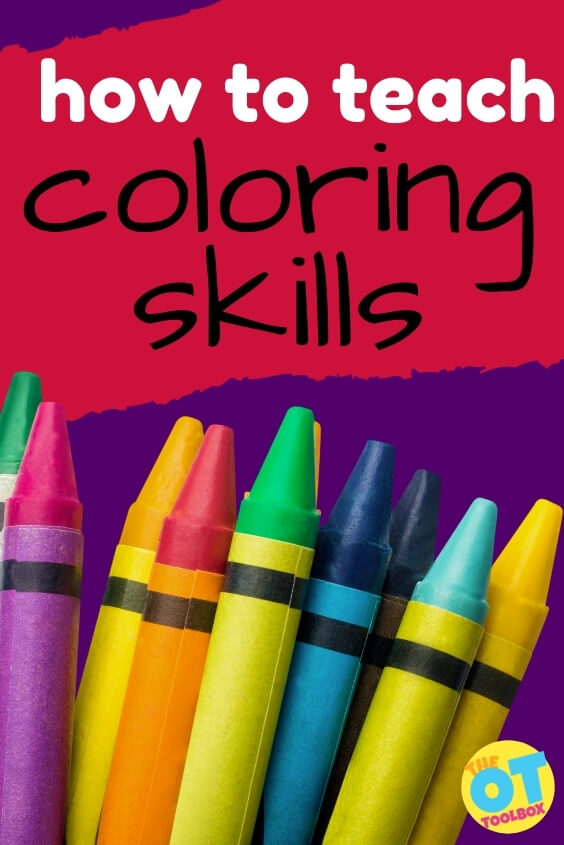
Coloring is such an important part of childhood and growing up. There are many benefits to coloring as a tool for building skills. Coloring develops hand strength, visual perceptual skills, and precision skills in grasp. It’s the first time many of us express creativity and produce something we are proud of. It boosts confidence, develops understanding of cause and effect, and increases attention spans.
Coloring is also an important stage of child development, too.
Did you know that drawing is also an integral part of many early childhood skills like pre-writing development, fine motor skills, and spatial reasoning?
Let’s go into age-appropriate specifics on how to teach coloring skills at each age and stage, from babies, to toddlers, to preschool, to Pre-K, to elementary aged children. Specifically, you’ll want to use age-appropriate crayons for toddlers, based on developmental levels.
How to teach coloring skills
Coloring can be hard for kids. Many times, you see kids that refuse to color. Other times you come across kids that prefer markers over crayons. There are reasons for these difficulties, that make sense developmentally. Let’s take a look at the reasons why kids hate to color.
- Coloring is HARD!
- It hurts the child’s hands to color
- Coloring makes the child’s hands tired
- Child prefers markers over crayons
- Coloring in the lines is hard
- It’s hard to finish a coloring page
All of these reasons why kids hate to color are related…and many times, it comes back to a need for developing hand strength and underlying skills.
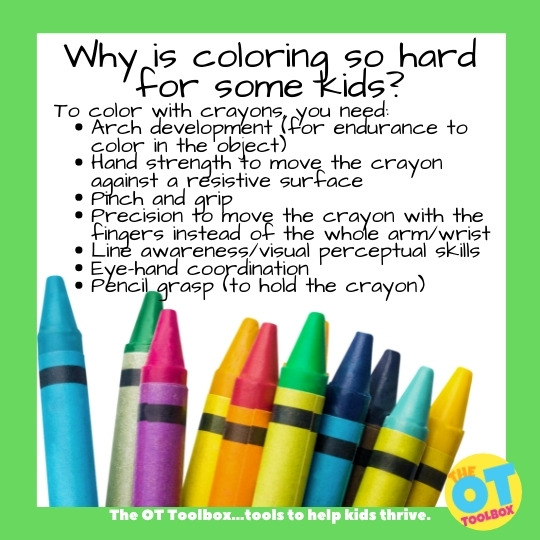
Skills needed for coloring
There are several areas, or underlying skills that play an important role in coloring:
- Arch development (for endurance to color in the object)
- Hand strength to move the crayon against a resistive surface
- Pinch and grip
- Precision to move the crayon with the fingers instead of the whole arm/wrist
- Line awareness/visual perceptual skills
- Eye-hand coordination
- Pencil grasp (to hold the crayon)
- Previous experience with fine motor activities/fine motor skill development
Fine motor skills and coloring- In order to hold a crayon, children need to develop fine motor skills. In order to color in a shape, hand strength is needed. In order to color within the lines, visual motor skills are needed. In order to color a whole shape or figure, distal mobility is needed.
Activities to develop these skills include fine motor play, beading, tweezer use, working on a vertical surface can develop these skills.
Line awareness and coloring– Another aspect of coloring is the line awareness to color within the lines. And, before a child can form letters with ease and fluency, they need to achieve pre-writing lines such as strait lines, squares, triangles, X and diagonals. This resource on line awareness can be a great starting point on this visual perceptual skills needed to color within the lines. Also try these tips to work on line awareness needed for coloring.
Pencil grasp and coloring– In order to teach coloring skills, it is important to progress through the stages listed below, whether at age level or not. Just like the underlying skills needed for pencil grasp development or handwriting, the basic levels need to be achieved. Before a child can hold a pencil with a functional grasp, they need to progress through more primitive grasp patterns such as a pincer grasp, palmer supinate grasp, digital pronate grasp, and quadrupod or static tripod grasp.
All of these underlying skills play an important role in how to teach coloring skills to kids!
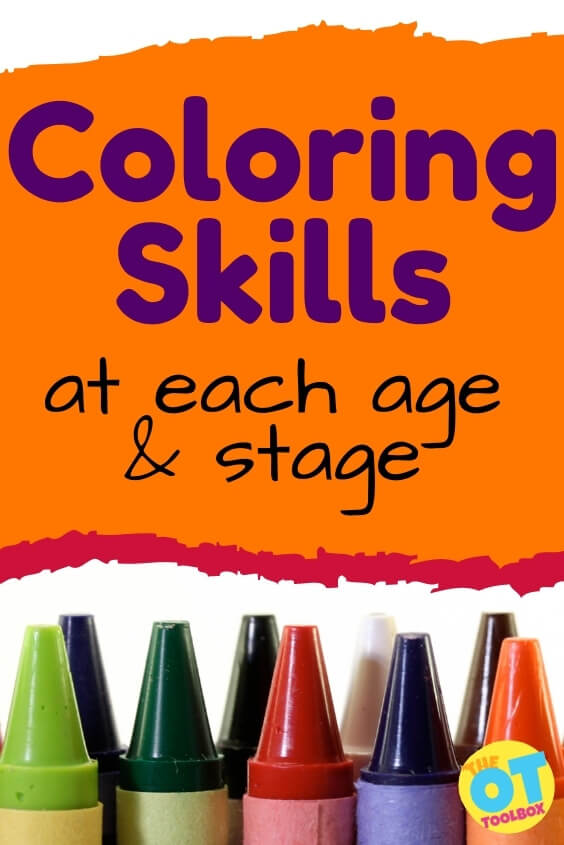
Coloring Skills By Age
In this post we will break down the coloring skills you can expect a child to do dependent on age. You will see that we break them down into age ranges – for good reason, too. Every child will develop different skills and different times. Generally, though, there is a developmental path that the majority of children will follow.
If you believe that your child is lagging behind in these skills, talk to your child’s health care team and let them know what you see in your child. They will direct you towards occupational therapy if it is right for your family!
Coloring Skills at BIRTH – 6 MONTHS
Not much coloring going on in this time frame, as you may imagine! Instead, your little one is prepping those little fingers to hold and manipulate objects, that will one day lead to purposeful scribbling!
I always recommend allowing your child to explore coloring as soon as they are able to hold a crayon in their hand and sit up safely in a high chair. Be sure to stay with your baby the whole time you are offering coloring opportunities, as they will likely put their crayons in their mouth.
Support the development of Coloring Skills during infancy:
Babies under six months will typically grasp a small object in the middle or pinky-side of their palm. This grasp pattern is strengthening the building blocks for more refined grasps down the road. Tummy time is a great tool for lengthening the ulnar side of the hand for strengthening so that endurance in fine motor tasks is achievable at older ages. Tummy time also supports arch development even at this young age.
While most parents of new babies will not be thinking of coloring, these activities support the development of MANY motor and cognitive skills, and not just coloring!
Coloring Skills before 1 year
From 6 months to 12 months, babies are certainly not coloring. However, they ARE developing motor and visual skills needed for holding and marking with a crayon in the later years.
Grasping patterns grow a lot during this time! Your baby will start to use their thumbs a little bit more while stacking blocks, be able to pick up their Cheerios with only their thumb and pointer finger (pincer grasp), and can point to objects with one finger. By 12 months old, we should see a pincer grasp while holding small objects. This grasp prepares little fingers for sustained coloring!
Support the development of Coloring Skills during In babies:
Around a year old, your little one may show more interest in scribbling. They will likely make large marks across the paper (and hopefully not the walls!) by using their whole arm to move their crayon. As they develop, you will see that those big movements will get smaller and smaller as fine motor skills are refined.
Grasp: On a coloring utensil, they will use a gross grasp that looks like a fist.
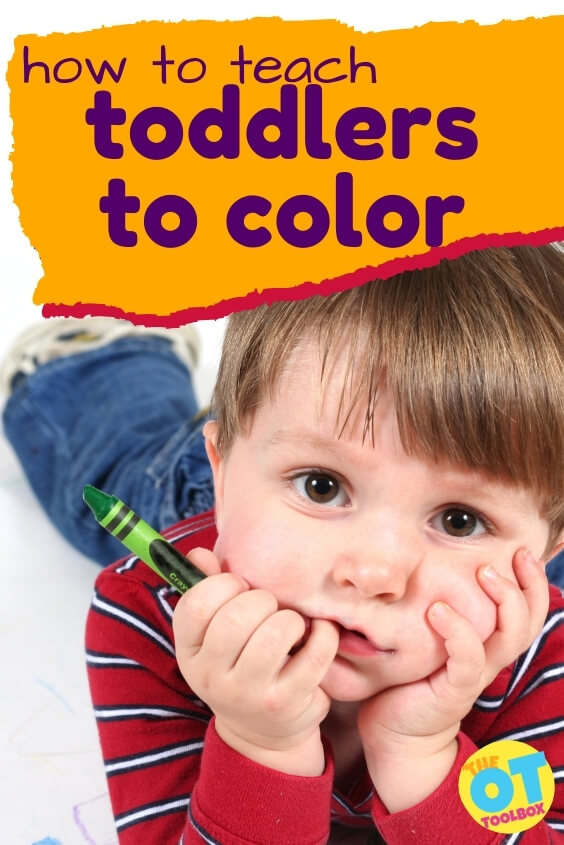
Coloring Skills for Toddlers
The toddler years, for from 12 months to 2 years, is a great window to introduce coloring. It’s during this age that toddlers show interest in coloring and develop skills needed for motor development. This is a great time to explore how to teach coloring skills at an impressionable age!
During the 12 month to two year range, toddlers are building proficiency in coloring skills…and this is a great time to teach coloring!
In this time frame, your toddler will begin to recognize colors and shapes in their environment, and may purposefully choose colors while they are scribbling on paper. They will start to hold their crayon or marker a little more gently, with their pinky down towards the paper, and all fingers wrapped around.
Teach Toddlers to Color:
During the toddler years, exposure is key! You can present many activities and coloring opportunities to color with crayons. Different types of crayons and coloring activities are great exposure, too. Here are tips to teach toddlers to color:
- Offer just one crayon at first. Offering too many options can overwhelm the young child.
- Try different crayon types. There are different crayon molds that are great for toddlers including egg shaped crayons, rock shaped crayons, or even bath crayons.
- Try coloring materials that require less hand strength or resistance, to make a mark. Kwik Stick tempera paints are a great option.
- Show toddlers how to color. Color alongside young children for an opportunity to connect with the child and interact. Toddlers love to mimic others and can learn a lot by watching their parent color alongside them.
- Offer toddler-friendly coloring pages. A big coloring book with many details can overwhelm a child. Try a printed page with simple shapes in smaller sizes.
- Don’t expect perfection. Just putting crayons to the page is a great learning experience that builds hand strength, eye-hand coordination, and coloring experience.
- Expect whole-arm movements. Toddlers color with their shoulder and elbow movements, or the proximal movements and won’t color with precise movements of the fingers until an older age. This is normal and to be expected. Coloring for toddlers looks like scribbling and that’s OK!
- Encourage coloring and mark-making with coloring games and toys. This post has games and toys for coloring that Toddlers will love.
- Work on fine motor hand skills through games involving tweezers, games on the floor, gross motor play, and whole body play activities.
- Encourage play with age-appropriate puzzles and blocks.
- Use our winter color by letter worksheet to work on coloring in small spaces.
Your child may start to show more interest in coloring just like you do, trying to copy your marks and paying closer attention to where they are placing their pen to paper. They should be able to copy a vertical line by around age two – this is a key marker for pre-writing skills. Usually around this time they also choose a preferred hand dominance while coloring!
The typical grasp pattern used by toddlers is the Palmar supinate grasp. This is a normal part of development.
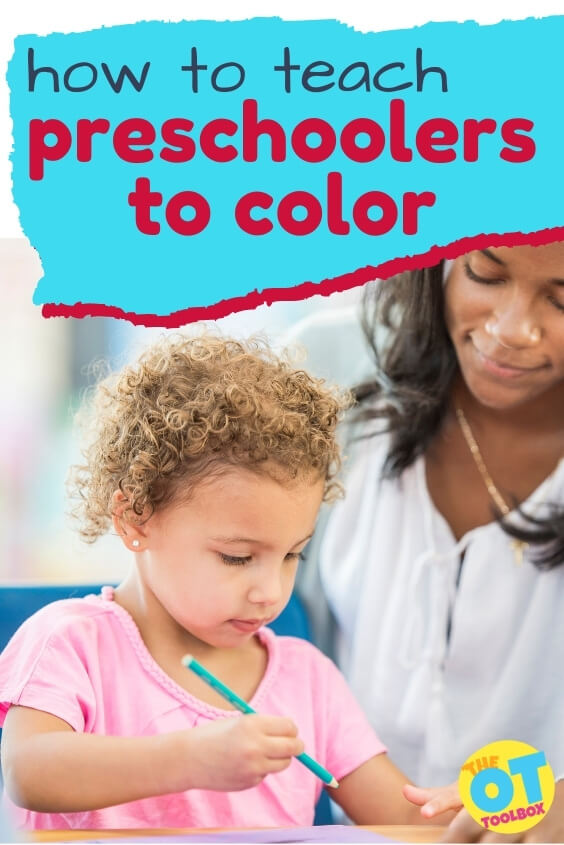
Coloring Skills for Preschool (2-3 years)
The early preschool years, or 2- 3 years of age are a prime range for developing beginning coloring skills.
Your young preschool child will start to shift their fingers towards the paper while they hold their coloring utensil by age three. Some children hold their pencil towards the top near the eraser during this stage of development. They should naturally work their fingers down the utensil, closer to the paper, as they get used to this new grasp.
Use these strategies to teach young preschoolers to color:
During the 2-3 year period, you can expect your child to start drawing meaningful images. They will point to a drawing that may look like nothing to you, but then they will tell you that it’s their dog! By age three, your child should be able to do the next pre-writing task: copy a horizontal line and a circle.
Teach Preschoolers to Color (2-3 years old):
For young preschoolers, continued exposure to coloring is necessary. So often, young children skip the needed PLAY that builds fine and gross motor skills. With more and more young children playing primarily on screens versus free play, independent play, and creative fine motor play that builds the necessary hand strength, mobility, dexterity needed for precision, endurance, and progression through typical grasp patterns. Children at the preschool stages need fine motor play, much less screen time exposure, and play experiences.
Another pet peeve of pediatric occupational therapists is the tendency to hand a young child a pencil or pen during the preschool years.
- Continue with the suggestions listed above for the baby stage.
- Use a variety of crayon types and sizes: regular crayons, finger crayons, egg-shaped crayons, rock crayons, jumbo crayons, bath crayons,
- Don’t be afraid to use broken crayons. Sounds strange, right? Sometimes a whole crayon is too big for small hands. A broken crayon can be the “just right” size and can be used as a strengthening tool for fine motor skills as well.
- Don’t expect perfection. Crayon lines will go over the border of the coloring area and that’s ok!
- Offer small coloring spaces with wider borders.
- Provide simple shapes for coloring opportunities.
- Offer physical boundaries if needed: Use wikki sticks around the coloring area, use your hands to create a small coloring space.
- Color small areas on an easel to engage the core as a stabilizer, work against gravity, to place the wrist into extension, to pull the fingers into a tripod type of grasp for dexterity.
- Continue easel work and play with lite brite, painting on easels, sticking and peeling tape to the wall, sticking foam pieces to a wet easel surface.
- Play with foam sheets on a window. Try this rainbow play activity where preschoolers can stick foam sheets to a wet window. Encourage use of a spray bottle to wet the window and then wipe with a towel to clean up any drips. (It’s a great way to teach colors to preschoolers, too!)
- Draw with chalk on a vertical chalk board or on a driveway/side walk.
- Try window paints.
- Try coloring materials that require less hand strength or resistance, to make a mark. Kwik Stick tempera paints are a great option.
- Show toddlers how to color. Color alongside young children for an opportunity to connect with the child and interact. Toddlers love to mimic others and can learn a lot by watching their parent color alongside them.
The typical grasp pattern used by young preschool children in the 2-3 year age range is the Digital pronate grasp. Use of this grasp pattern is a typical stage of grasp development.
Coloring Skills in Preschool (4-5 years)
During the later preschool years, at four and five years of age, preschoolers are developing more refined coloring skills as their motor and visual develop integrate.
Around age four is when you can start to see recognizable images appear more regularly in your child’s artwork. Four-year-olds will usually draw people with two, three, or four body parts. For example, the person may have a circle for a head, a rectangle for the body, and two circles for feet.
By the time they are five, they will likely be drawing people with six or more body parts! You will see their drawings becoming more and more life-like, by adding details like fingers, eye color, and buttons on clothing.
By age four, we expect a child to be able to copy a cross – a very tricky visual motor skill! Around age five, we would expect a child to be able to copy a square and color inside the lines fairly well.
Teach Preschoolers to Color (4-5 years old):
For older preschoolers, especially those in Pre-K, it can be common to see preschools and pre-K classrooms where young children are expected to write letters, write their name, or trace letters. This is potentially damaging for the young child and not recommended by pediatric occupational therapists. This premature exposure to writing with pencils, tracing letters, and writing letters isn’t based on child development of motor skills.
It will result in forming letters incorrectly and establishing poor motor plans for letters. It will result in poor pencil grasps that are difficult to change. It will result in forming letters from the bottom or in “chunks”. It is a detriment to children, especially because there is little time in the kindergarten classroom for working on letter formation, pencil grasp instruction beyond the regular curriculum. So changing motor plans and muscle memory that has been poorly established is detrimental for the young child.
What preschool and Pre-K children at 4 and 5 years of age need is play and the opportunity to develop and refine fine motor skills, hand strength, eye-hand coordination, visual motor skills. These skills are strengthened through play.
Try these strategies to teach older preschoolers/Pre-K children to color:
- Use all of the strategies previously listed above.
- Encourage coloring with interest-based coloring pages (run a Google search for coloring pages, i.e. “unicorn coloring pages”, “superhero coloring pages”, etc. You can generally find free printable coloring pages in most themes.)
- Show off art work! Create a space in the home or clinic where coloring projects can be displayed. This is a great motivator for many children.
- Encourage smaller coloring areas to improve eye-hand coordination with line use. A smaller coloring space enables children to use their fingers to move the crayon rather than the wrist, elbow, or shoulder.
- Use a smaller or broken crayon to promote a developmentally appropriate quadripod or static tripod grasp.
- Use simple shapes with curved lines like circles and ovals to promote smooth coloring lines with minimal direction changes and angles to the coloring picture.
- If children are complaining of tired hands or tend to switch crayon colors a lot, it can be a sign of weakness in the hands. To strengthen the hands, encourage play with tweezers, tongs, spray bottles, pinch and grip activities, LEGO blocks, play dough, beading activities, peg boards, etc.
- If you have a box of crayons with a crayon sharpener on the back, encourage the child to use it to sharpen crayons. The built-in sharpener is great for not only sharpening dull crayons, but also as a hand strengthening device!
The typical grasp pattern in preschool years for 4-5 year olds is the quadrupod or static tripod grasp. Use of either of these grasps is part of typical grasp development.
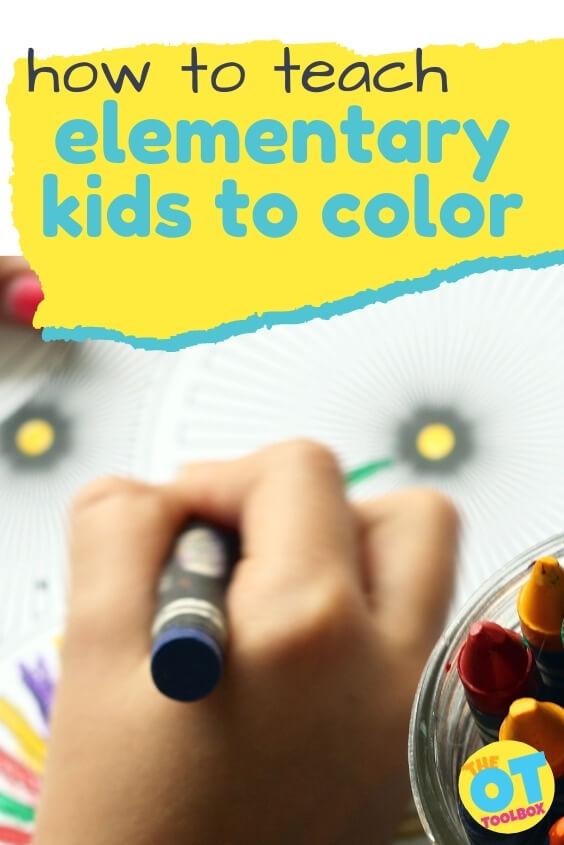
Coloring Skills at 5-6 years old
Somewhere between ages five and six, we would expect a child to be able to copy multiple shapes, including the ones they would have mastered in the past (i.e. vertical, horizontal, and crossed lines).
Around age five we would like to see what is called a dynamic tripod grasp when a child is writing or coloring. They should have their pencil between their pointer finger and thumb, with the middle finger supporting and the ring and pinky fingers tucked away into the palm. This grasp is “dynamic” if the fingers can move separately from the palm and wrist, allowing for good control of the writing utensil. This growing strength and control is why we see handwriting and coloring skills develop!
By age six, they should be able to copy more complex shapes, like triangles and rhombuses. You could expect them to independently draw some of the more simple shapes as well, like circles and squares.
The dynamic tripod grasp is the most advanced pencil grasp and should continue throughout their life. Typically, whatever grasp a child has habituated by age 6 is the grasp they will likely continue to have.
Teach kids to color at 5-6 years:
Try these strategies to teach children aged 5-6 years old children to color:
- Use all of the strategies listed above under preschool, older preschool, etc.
- Color using a variety of surfaces and mediums.
- Color using squeeze paints to work on hand strength.
- If hand strength is a challenge and the 5-6 year old complains of hand fatigue, try a less resistive coloring tool such as twist crayons.
- Work on coloring larger areas for longer periods of time.
- Use raised line borders if needed, including Wikki Stix or dry glue to border the coloring area.
- Try a 3 crayon challenge.
- Highlight the line with a marker. A bright color can be a visual cue of where to write. Letters should rest on the line. You can start with a nice thick and brightly colored highlighter like this one and move to a thinner pen like these ones. Sometimes the visual cue of that bright line is enough to keep letters placed correctly.
- Another strategy to work on line awareness in coloring is to add bolder coloring shape lines with more contrast by darkening the borders with a black marker. Simply outline the shape with a black marker for a visual prompt.
- For kids that show a great deal of difficulty with coloring in a given space, use a stencil made from a thing cardboard like a recycled cereal box. Cut out a rectangle and place it over the given writing space. This will help to remove distractions of the rest of the page and proved a designated space to color within.
- Use glue to trace along the outside border of the coloring space. Let the glue dry and then use that tactile border as a physical prompt for coloring lines.
The typical grasp pattern for 5-6 year olds is a tripod/dynamic tripod grasp.
Coloring Skills at SIX YEARS OLD AND BEYOND
Older children can sometimes struggle with coloring and see their peers who seem to have little trouble at all. This can be a stab at their confidence and self-esteem. For older children, coloring often-times is a “sometimes” task in the classroom, so there are limited opportunities for a hands-on fine motor task. Still older students use primarily colored pencils to color in the classroom. Coloring with colored pencils requires even more hand strength, precision, and mobility with the pencil, so this can be a challenge.
Try these strategies for teaching older kids coloring skills:
- To teach coloring skills to older children, use all of the methods mentioned under each age level above.
- Your elementary-aged child will continue to develop fine motor skills for writing and coloring, as well as manipulating other craft media like clay, papier mache, etc. Creating things with their hands will not only strengthen their muscles but will also benefit their social development, self-esteem, and problem solving skills.
- Work on coloring with a variety of crayon types, markers, or paint pens.
- Use a variety of coloring surfaces.
- If crayon pressure or colored pencil pressure is a problem, try these strategies to address pressure on the writing utensil.
- Use a coloring journal or a drawing journal.
- Use interest-based coloring books or coloring pages.
A final note on teaching coloring skills
If wondering exactly how to teach coloring skills to children at various ages is something you are looking for developmentally appropriate strategies, this comprehensive resource is for you. Coloring is a child occupation needed for learning, interactive play, and creative play.
Encourage your kids at all stages of development to explore their creativity and the fine motor, visual motor, cognitive and socioemotional skills will follow.
Use some coloring activities like our President’s Day coloring pages for themed coloring fun.
References
Dosman, C. F., Andrews, D., & Goulden, K. J. (2012). Evidence-based milestone ages as a framework for developmental surveillance. Paediatrics & Child Health,17(10), 561–568. https://doi.org/10.1093/pch/17.10.561
Centers for Disease Control & Prevention. (n.d.). Milestone moments: Learn the signs. Act early. Retrieved from: https://www.cdc.gov/ncbddd/actearly/pdf/parents_pdfs/milestonemomentseng508.pdf
How to Teach Coloring Skills is a collaborative article by Colleen Beck, OTR/L and Sydney Rearick, OTS.

Colleen Beck, OTR/L has been an occupational therapist since 2000, working in school-based, hand therapy, outpatient peds, EI, and SNF. Colleen created The OT Toolbox to inspire therapists, teachers, and parents with easy and fun tools to help children thrive. Read her story about going from an OT making $3/hour (after paying for kids’ childcare) to a full-time OT resource creator for millions of readers. Want to collaborate? Send an email to contact@theottoolbox.com.


Sydney Thorson, OTR/L, is a new occupational therapist working in school-based therapy. Her
background is in Human Development and Family Studies, and she is passionate about
providing individualized and meaningful treatment for each child and their family. Sydney is also
a children’s author and illustrator and is always working on new and exciting projects.
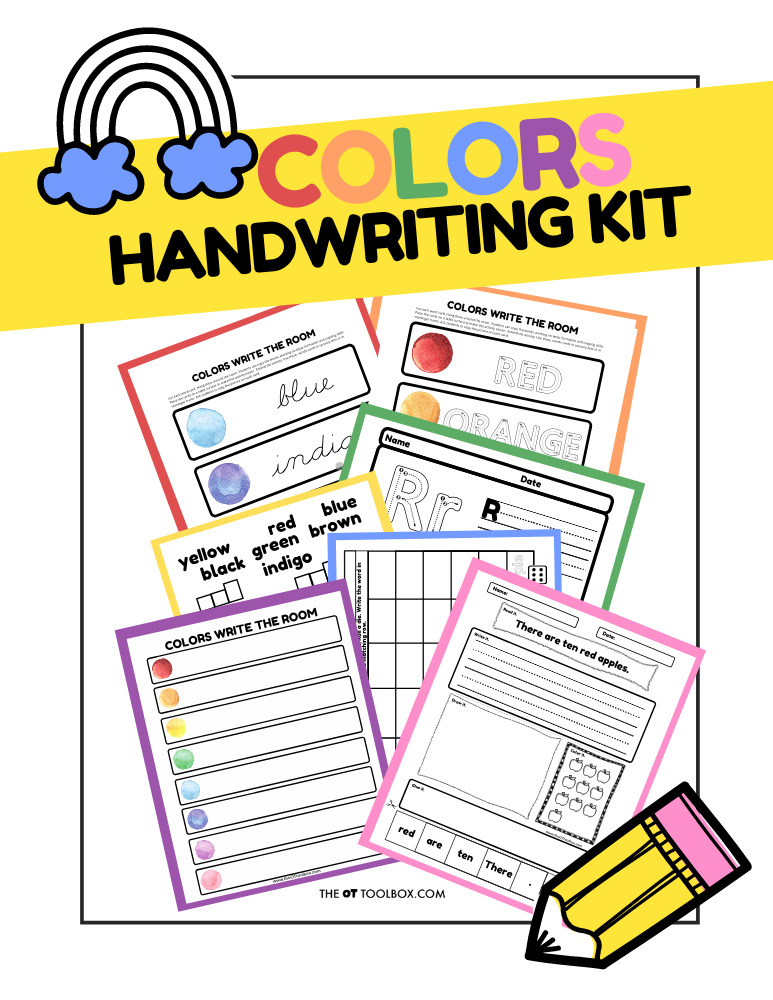

Rainbow Handwriting Kit– This resource pack includes handwriting sheets, write the room cards, color worksheets, visual motor activities, and so much more. The handwriting kit includes:
- Write the Room, Color Names: Lowercase Letters
- Write the Room, Color Names: Uppercase Letters
- Write the Room, Color Names: Cursive Writing
- Copy/Draw/Color/Cut Color Worksheets
- Colors Roll & Write Page
- Color Names Letter Size Puzzle Pages
- Flip and Fill A-Z Letter Pages
- Colors Pre-Writing Lines Pencil Control Mazes
- This handwriting kit now includes a bonus pack of pencil control worksheets, 1-10 fine motor clip cards, visual discrimination maze for directionality, handwriting sheets, and working memory/direction following sheet! Valued at $5, this bonus kit triples the goal areas you can work on in each therapy session or home program.



Colleen Beck, OTR/L has been an occupational therapist since 2000, working in school-based, hand therapy, outpatient peds, EI, and SNF. Colleen created The OT Toolbox to inspire therapists, teachers, and parents with easy and fun tools to help children thrive. Read her story about going from an OT making $3/hour (after paying for kids’ childcare) to a full-time OT resource creator for millions of readers. Want to collaborate? Send an email to contact@theottoolbox.com.






